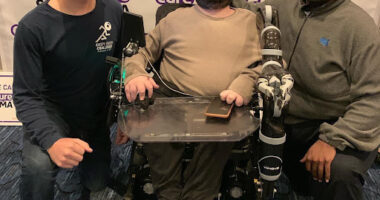
Rio Landa: Figuring out your SMA care team
Rio Landa, whose 14-year-old son, Mateo, was diagnosed with SMA type 2 when he was a year old, discusses how she’s grown to trust each SMA healthcare team member’s specialty.
 Find a specialist near you
Find a specialist near you
Transcript
My child’s care team, you know, we have a pediatrician that actually is pretty familiar with SMA, which is really helpful.
And you know, she messaged me and said, “Hey, I see Mateo’s having a surgery soon.”
And yeah, I was like, “Oh yeah, he’s having a back fusion.”
She’s like, “Oh gosh.”
You know, things, areas like that, which, you know, being a parent and kind of knowing that was on the horizon and also being in healthcare, we’re probably a little bit more comfortable there, I think, than most parents would be.
But pediatrician — she’s the one that goes, that everyone will go to for basic needs and really use her if he feels sick.
I think another big thing is that she does video visits. And so not having to come into the office every time after she’s met us a couple of times is great because she’s comfortable with us. And so we do not have to go in every time, which is very convenient. Especially when you get older and kids are doing more, or adults are doing more.
Who else is part of his team? So I would say neurology and pulmonology are probably doctors that we see the most of. They are an integral part of his team, as well as physical therapy is huge actually.
We’re really lucky to live in an area where we have a multidisciplinary clinic. So, you know, we, right down the street, I’m able to go to MDA, a neuromuscular clinic, and see pulmonology, neurology, ortho if we need it, and physical therapy, occupational therapy in the same day.
It’s an exhausting day, but the really good thing is that we can go see everyone, and if I, you know, I forgot to ask, “Oh, he might need a new bath chair because we’ve kind of been making do,” and they’re like, “Hey, how’s his equipment?” And every time they make us run through, “What does he have?”
And it’s redundant at first. It’s like, we have this and this and this, but it takes 20 minutes. But it’s really important. It’s like, “Oh, yeah, he’s having a big procedure. So, oh, and we’re due for a new bath chair.” And the physical therapist said, “Great, I don’t need to see you again. Just send me a message on MyChart.”
And that way, in MyChart, all the providers can see everything. So our neurologists and pulmonologists are able to see that. So when the DME company sent the prescription for a doctor to sign, it was really easy to get signed because everyone was on the same page.










